Jeux de coloriage¶
Le notebook explore quelques problèmes de géométrie dans un carré.
[1]:
%matplotlib inline
Colorier un carré à proportion¶
On souhaite colorier 20% d’un carré. Facile !
[2]:
import matplotlib.pyplot as plt
import matplotlib.patches as pch
def carre(ax=None):
if ax is None:
fig, ax = plt.subplots(1, 1, figsize=(2, 2))
ax.plot([0, 0, 1, 1, 0], [0, 1, 1, 0, 0], "k-")
ax.set_title("Carré")
return ax
ax = carre()
ax.add_patch(pch.Rectangle((0, 0), 0.2, 1, color="blue"));
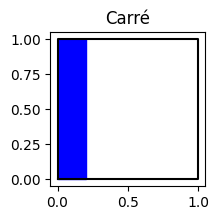
Colorier en diagonale¶
[3]:
import numpy
ax = carre()
ax.add_patch(
pch.Polygon(numpy.array([(0, 0), (0.2, 0), (0, 0.2), (0, 0)]), color="blue")
);
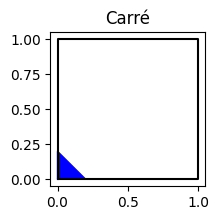
Moins facile…
Fonction de la surface couverte¶
[4]:
def surface(x):
if x <= 1.0:
return x**2 / 2
if x <= 2.0:
return surface(1) + 0.5 - surface(2 - x)
fig, ax = plt.subplots(1, 1, figsize=(8, 4))
X = numpy.arange(0, 200) / 100
Y = [surface(x) for x in X]
ax.plot(X, Y)
ax.set_title("Surface diagonale en fonction de x")
ax.set_xlabel("x")
ax.set_ylabel("% couvert");
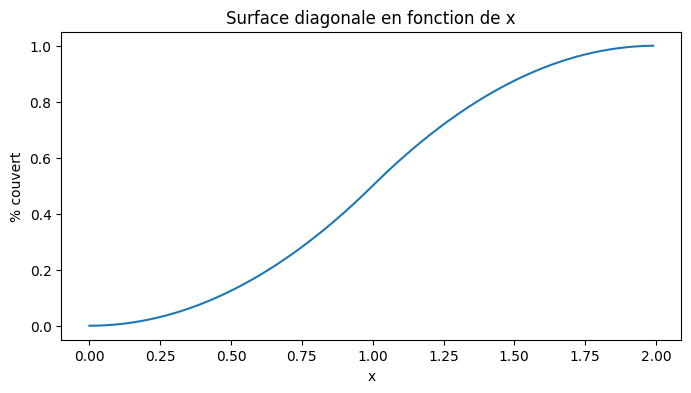
Ce qui nous intéresse en fait, c’est la réciproque de la fonction. Première version, sans savoir calculer mais en supposant qu’elle est croissante.
[5]:
def surface_inverse(y, precision=1e-3):
x = 0
while x <= 2:
s = surface(x)
if s >= y:
break
x += precision
return x - precision / 2
surface_inverse(0.2)
[5]:
0.6325000000000005
[6]:
fig, ax = plt.subplots(1, 1, figsize=(4, 4))
X = numpy.arange(0, 200) / 100
Y = [surface(x) for x in X]
ax.plot(X, Y, label="surface")
X2 = numpy.arange(0, 100) / 100
Y2 = [surface_inverse(x) for x in X2]
ax.plot(X2, Y2, label="surface_inverse")
ax.set_title("Surface diagonale en fonction de x")
ax.legend();
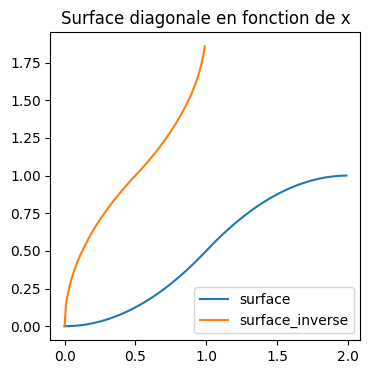
Ca marche mais…
[7]:
%timeit surface(0.6)
139 ns ± 3.21 ns per loop (mean ± std. dev. of 7 runs, 10,000,000 loops each)
[8]:
y = surface(0.6)
%timeit surface_inverse(y)
120 µs ± 10.3 µs per loop (mean ± std. dev. of 7 runs, 10,000 loops each)
Et c’est de plus en plus long.
[9]:
%timeit surface_inverse(y * 2)
197 µs ± 53.6 µs per loop (mean ± std. dev. of 7 runs, 1,000 loops each)
Il y a plus court.
[10]:
def surface_inverse_dicho(y, a=0.0, b=2.0, precision=1e-3):
while abs(a - b) >= precision:
m = (a + b) / 2.0
s = surface(m)
if s >= y:
b = m
else:
a = m
return (a + b) / 2.0
surface_inverse_dicho(0.2)
[10]:
0.63232421875
[11]:
fig, ax = plt.subplots(1, 1, figsize=(4, 4))
X = numpy.arange(0, 200) / 100
Y = [surface(x) for x in X]
ax.plot(X, Y, label="surface")
X2 = numpy.arange(0, 100) / 100
Y2 = [surface_inverse(x) for x in X2]
ax.plot(X2, Y2, label="surface_inverse")
X3 = numpy.arange(0, 100) / 100
Y3 = [surface_inverse_dicho(x) for x in X2]
ax.plot(X2, Y2, ".", label="surface_inverse_dicho")
ax.set_title("Surface diagonale en fonction de x")
ax.legend();
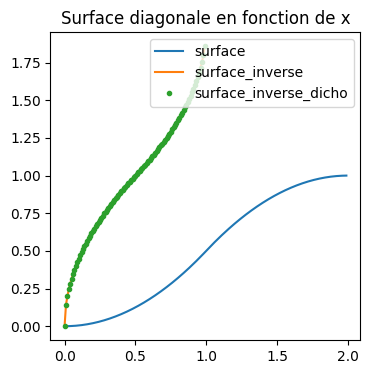
Ca marche.
[12]:
y = surface(0.6)
%timeit surface_inverse_dicho(y)
2.9 µs ± 280 ns per loop (mean ± std. dev. of 7 runs, 100,000 loops each)
[13]:
%timeit surface_inverse_dicho(y * 2)
3.74 µs ± 252 ns per loop (mean ± std. dev. of 7 runs, 100,000 loops each)
Près de 50 fois plus rapide et cela ne dépend pas de y cette fois-ci. Peut-on faire mieux ? On peut tabuler.
[14]:
N = 100
table = {int(surface(x * 1.0 / N) * N): x * 1.0 / N for x in range(0, N + 1)}
def surface_inv_table(y, N=N, precision=1e-3):
i = int(y * N)
a = table[i - 1]
b = table[i + 1]
return surface_inverse_dicho(y, a, b, precision=precision)
surface_inv_table(0.2)
[14]:
0.63234375
[15]:
y = surface(0.6)
%timeit surface_inv_table(y)
2.03 µs ± 221 ns per loop (mean ± std. dev. of 7 runs, 100,000 loops each)
[16]:
y = surface(0.6)
%timeit surface_inv_table(y * 2)
1.62 µs ± 30.7 ns per loop (mean ± std. dev. of 7 runs, 100,000 loops each)
C’est mieux mais cette solution est un peu défectueuse en l’état, trouverez-vous pourquoi ? L’expression len(table) devrait vous y aider.
[17]:
len(table)
[17]:
51
Version mathématique¶
Pour cette fonction, on sait calculer la réciproque de façon exacte.
[18]:
def surface(x):
if x <= 1.0:
return x**2 / 2
if x <= 2.0:
return surface(1) + 0.5 - surface(2 - x)
def surface_inv_math(y):
if y <= 0.5:
# y = x**2 / 2
return (y * 2) ** 0.5
else:
# y = 1 - (2-x)**2 / 2
return 2 - ((1 - y) * 2) ** 0.5
surface_inv_math(0.2), surface_inv_math(0.8)
[18]:
(0.6324555320336759, 1.3675444679663242)
[19]:
y = surface(0.6)
%timeit surface_inv_math(y)
152 ns ± 11.1 ns per loop (mean ± std. dev. of 7 runs, 10,000,000 loops each)
[20]:
y = surface(0.6)
%timeit surface_inv_math(y * 2)
163 ns ± 13.2 ns per loop (mean ± std. dev. of 7 runs, 10,000,000 loops each)
Il n’y a pas plus rapide mais cette option n’est pas toujours possible. Je passe la version écrite en C++, hors sujet pour le moment.
Retour au coloriage¶
[21]:
def coloriage_diagonale(y, ax=None):
ax = carre(ax)
if y <= 0.5:
x = surface_inv_math(y)
ax.add_patch(
pch.Polygon(numpy.array([(0, 0), (x, 0), (0, x), (0, 0)]), color="blue")
)
else:
ax.add_patch(
pch.Polygon(numpy.array([(0, 0), (1, 0), (0, 1), (0, 0)]), color="blue")
)
x = surface_inv_math(y) - 1
ax.add_patch(
pch.Polygon(numpy.array([(1, 0), (1, x), (x, 1), (0, 1)]), color="blue")
)
return ax
fig, ax = plt.subplots(1, 2, figsize=(6, 3))
coloriage_diagonale(0.2, ax=ax[0])
coloriage_diagonale(0.8, ax=ax[1])
ax[0].set_title("20%")
ax[1].set_title("80%");
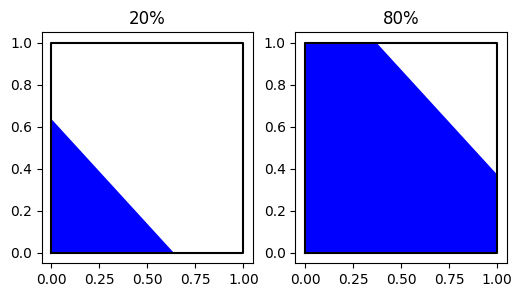
A quoi ça sert ?¶
Une programme est la concrétisation d’une idée et il y a souvent un compromis entre le temps passé à la réaliser et la performance qu’on souhaite obtenir. Et c’est souvent sans fin car les machines évoluent rapidement ces temps-ci.
[ ]: